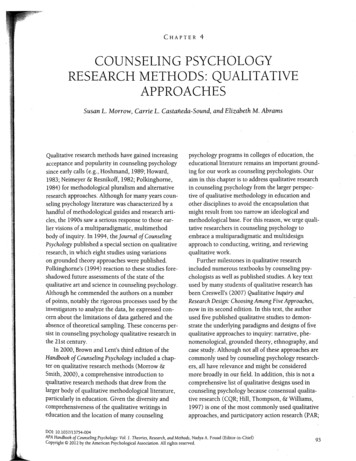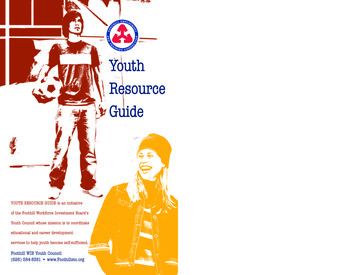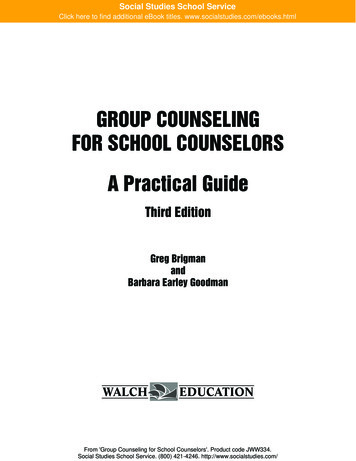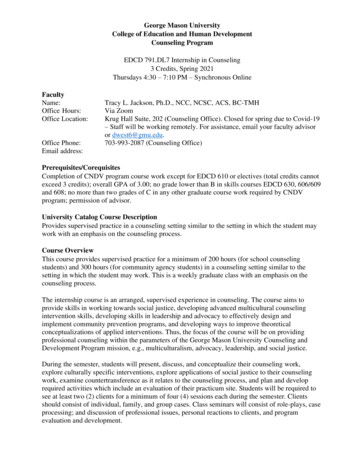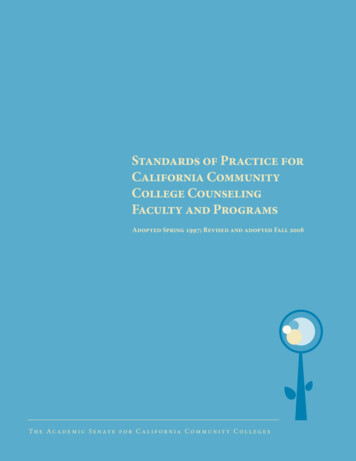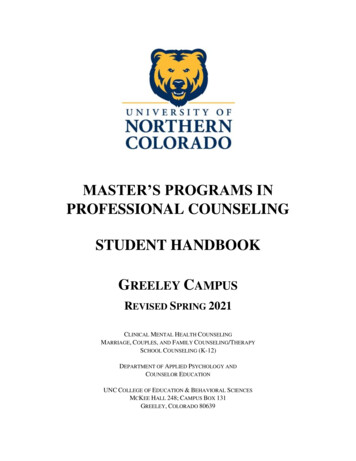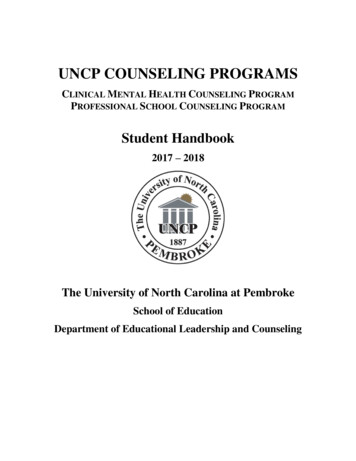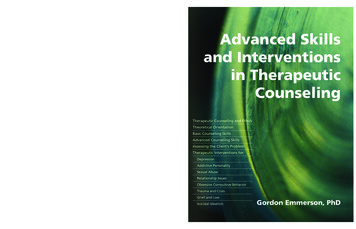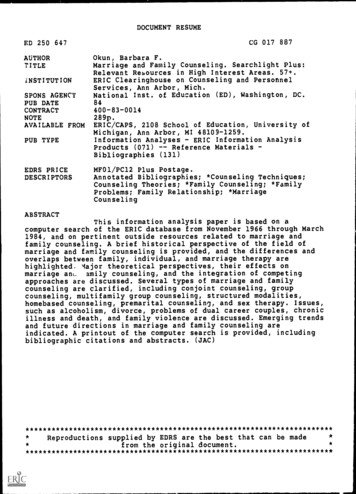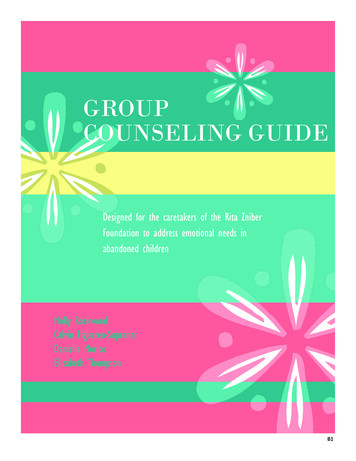
Transcription
GROUPCOUNSELING GUIDEDesigned for the caretakers of the Rita ZniberFoundation to address emotional needs inabandoned childrenMolly RockwoodCalvin Figuereo-SupranerDaniella MoricoElizabeth ThompsonB1
Table of ContentsIntroduction . .B3Facilitating Meaningful Conversation .B7Activities and Icebreakers . . B11Conversation . .B39Conclusion .B41Bibliography . .B43B2
INTRODUCTIONB3
ABOUT THE BOOKThis book contains a collection of therapeutic activities adapted tothe needs of the caretakers of the Rita Zniber Foundation to helpfacilitate group counseling sessions.The goal of these activities is to facilitate healthy conversations thataddress common emotional problems stemming from abandonmentbetween the caretakers and the children.These activities are in no way a substitute for professionalpsychological help. If the caretakers suspect that a child has aserious mental problem, we encourage them to seek the help of aprofessional.B4
PLAY THERAPY“Play is the highest development in childhood, for it alone is thefree expression of what is in the child’s soul.children’s play is notmere sport. It is full of meaning and import” (Landreth, 2002).In the early 1900s, therapists realized that the counseling techniquesused with adults were not beneficial to children. Many children areunable and uninterested in exploring their feelings verbally as adultsdo. Because of this, play therapy was created as a therapeutictechnique to address children’s problems. Play therapy is built basedon the communicative and learning processes of children. It helpschildren to learn about themselves and their relationships withothers (Landreth, 2002).B5
GROUPCOUNSELING“Hearing from other people about how you come across can be verypowerful. You get a wider range of perspectives on your situation,and that can help you deal with your problems better.” - BenJohnson (Orenstein, 2014).Although talking about personal problems in front of other peoplecan be a daunting task, group counseling sessions can be incrediblyrewarding. A group of people processing similar experiences canmake for a strong support system. It is also often helpful to hearhow others have responded in comparable situations when decidingon appropriate responses. Talking in a group can also lessen feelingsof isolation and allow an opportunity to converse. Lastly, hearing theproblems of others can help keep one’s outlook in check (Johnson).B6
FACILITATINGMEANINGFULCONVERSATIONB7
ROLE OF THEFACILITATORA facilitator’s role is to help guide healthy group conversations. You can do this by helping tocreate a safe, inclusive environment in which the children feel comfortable talking. It isimportant to keep the communication positive so that you can be sure the conversation isconstructive and helpful to everyone involved. You should also keep in mind that it may bedifficult for people to share their thoughts, feelings, and experiences. Be sure to encourage allchildren in the group to participate (Prendville,P).Talking about issues as a group can help people come to healthy solutions. It is important tohave a plan of what you, as the facilitator, would like the outcome of the conversation to be.This way you will know how to steer the conversation back towards the goals if theparticipants become distracted. You can come up with a plan for the conversation byaccomplishing the following:1. Examining the Issues: Know what problem you are trying to address. Tell the groupabout it and make sure they are looking to address the same problem.2. Acknowledging Opinions and Feelings: It is important to acknowledge when someonehas an emotional stake in an issue. By addressing these emotional needs you can betterkeep the conversation from escalating.3. Decide How to Move Forward: Once everyone has the chance to voice their opinion onthe problem, they can begin to voice their opinions on what they think the solution is(Prendville,P).It is recommended that you read the educational guide before attempting to complete theseactivities. This book will familiarize you with the common problems that various age groupsand abandoned children face. With this knowledge you can better understand the children'spoint of views, which will help lead to a better conversation (Prendville,P).B8
CREATING A SAFESPACEIt is very important to create a safe and trusting environment during counseling sessions. Designing a spacewhere a child feels safe will help them to open up and feel more comfortable talking about his or herproblems. There are many ways to accomplish this and it is important to note that every child will bedifferent. Some are comforted by touch while others require more space to feel comfortable. The followingare tips to create a safe space in a group counseling environment (A. McCauley)1. ConsistencyCreate a set schedule for when the group counseling sessions will occur. Pick a day of the week and timethat the group will meet and maintain it. Make sure the children do not miss a meeting. This will help thechildren feel mentally and emotionally prepared. When they have the opportunity to prepare themselves theywill feel more comfortable talking because they will not be surprised and they will know what theexpectations are (A. McCauley).2. ConfidentialityMake it clear to the children that what is said in the group counseling session should stay in the group.Conversations should not be discussed with the other children. Be honest about what information will staybetween you and the group and what information will be shared with other caretakers. It is important thatonce these boundaries are established, they are respected (A. McCauley).3. TrustTrust needs to be built in the group. It does not happen immediately, and children will take differentamounts of time to establish a sense of trust. Begin the counseling group by talking about less personalsubjects, then build your way up to the more intense conversations (A. McCauley).B9
HOW TOFACILITATE GROUPCOUNSELINGA group counseling section should be divided up into three segments: activity, conversation, and conclusion.Each segment has a specific purpose. The activity segment is used to introduce the topic of discussion forthe day. Activities are a fun way to introduce the topic and prepare the children for discussion. Theconversation segment should be more direct. In this segment you can ask open-ended questions about thetopic of discussion and find out the children’s thoughts and feelings. The conclusion segment is a timedevoted to highlighting the main points of discussion. This time should also be used to end the counselingsession on a positive note (A. McCauley).Different age groups should spend different amounts of time in each segment. Each age group has specificneeds based on their attention spans and their capacity to discuss and understand complex emotions. Thefollowing is a suggestion for how much time should be spent for each segment with each age group (A.McCauley):Ages 2-6: Very Structured30 minutes: ActivityAges 6-10: Mildly Structured30 minutes: Activity10 minutes: ConclusionAges 10-13: Mildly Unstructured15 minutes: Activity20 minutes: Talking10 minutes: ConclusionAges 13-18: Unstructured15 minutes: Activate30 minutes: Talking15 minutes: ConclusionAs the children get older, they do not need as much structure for the group counseling session. The olderchildren are able to talk about their problems, and can have more complex discussions that may requirefreer conversation (A. McCauley).B10
ACTIVITIES ANDICEBREAKERSB11
MY HANDS CANSAY.GoalsTo encourage children to express how they are feeling using their hands and wordsAge2-5DirectionsTalk to the child about times when he or she has felt hot, cold, angry, scared or happy. Ask the child to show with handshello, come here, go away, I’m hot, scared, stop, angry, cold, goodbye, etc. Encourage the child to describe movements foreach emotion: “I wave my hand to say goodbye”, “I wrap my arms around me when I’m cold”Why it worksThis activity teaches children to discuss negative emotions like anger and fear. Eventually, it may become easier for kids toresolve conflicts and guide their behaviors in appropriate ways.(Adapted from My Hands Can Say )B12
CLAP A NAMEGoalsTo help children feel specialTo help children learn the names of their friendsTo develop basic speaking skills by learning syllablesAge2-4DirectionsExplain that a syllable is a small speech sound and that words are made up of syllables. Then, show how to clap for eachsyllable in their name as their name is read aloud.Why it worksThis activity helps teach how syllables work, which is an important skill in phonological awareness.TipsSing a song with the child’s name and clap the syllables(Adapted from Clap a name)B13
STAR OF THE DAYGoalsTo help build confidenceTo allows kids to express their feelingsAge5-6MaterialsMarkerPaper (in the shape of stars)Bag/basketDirectionsWrite children’s names on stars. Have all the children sit on the floor. Shake the bag and pull out a star. Then, read thename and have the child stand up. Introduce the child and compliment him or her. Ask the other children to share somethingnice about him or her.Why it worksYoung children feel great pride in even the smallest accomplishments.It is important for all adults in a child’s life to foster these feelings of pride and self-confidence.(Adapted from Star of the Day)B14
I CAN HELPGoalsTo help children recognize emotionsAge5-6MaterialsMarkersPaperDirectionsDraw a happy face on the paper. Ask the child what it represents. Then, ask him or her to list things that make him or herhappy. Ask the child what he or she can do to feel happy. Draw an unhappy face and repeat the process. Ask child what hecan do if he sees a friend who is unhappy. Draw an angry face and repeat the process again.Why it worksThis helps children talk about recognizing emotions and how to change their feelings towards them.(Adapted from I Can Help)B15
PASS THE HATGoalsTo help children learn to recognize and express emotions.Age3-5MaterialsPictures depicting different emotionsHat/Basket/EnvelopeDirectionsHave the kids sit down in a circle. Place all of the pictures in a hat. Pass the hat and play music. Stop the music after 15-20seconds. The child who is holding the hat picks a picture out. Ask the child to identify the emotion and to express how he orshe looks when he or she feels that way. Then, have the child describe a time when he or she felt that way. Continue passinghat until all the children have had a chance to play.Why it worksThis activity provides children with the chance to practice different feelings in a safe environment.(Adapted from Pass the Hat)B16
(Pass the Hat)B17
TELEPHONEGoalsTo help children understand the importance of communication.Age4-6DirectionsSit the children in a line or in a circle. Think of any sentence like, “Cookies are sweeter than biscuits” or “I have never seena green giraffe”. Whisper the sentence into the ear of the first child. That child whispers what he or she heard into the earof the second child and so on until all the children have gone. The sentence cannot be repeated. The last child says the sentence aloud to compare it to the original sentence. Afterwards, you can talk about the importance of clearly communicatingyour feelings and needs.Why it worksThis game helps children understand the importance of listening well and communicating clearly.(Adapted from The Telephone Game)B18
SHOW ME WHEN.GoalsTo develop vocabulary for talking about emotionsTo develop self-awarenessAge3-6DirectionsSay an emotion aloud. Allow all the kids to try and express the emotion silently using only hand gestures and facial expressions. Talk about what makes someone feel this emotion. Ask them what they would do when they feel this emotion. Then,ask what do they do when they see someone else with this emotion. Repeat with more emotions.Why it worksThis activity gets kids talking about emotions while they learn ways to recognize them and express themselves.(Adapted from Bryson, T)B19
THE LISTENINGGAMEGoalsTo practice good listening skillsAge3-5MaterialsVarious objectsDirectionsHave the kids sit down on the floor. Find several items (a comb, a glass, a spoon, etc.) and show them to the children. Havethe children close their eyes and listen while you pick up one of the items and make a sound with it (running you fingeralong the comb, tapping the glass, hitting the spoon against the floor). Put the item down and have the child open their eyesand guess which item made the sound.Why it worksThe children must listen carefully to determine which item made the sound.(Adapted from Overland, H)B20
MY FRIEND IN THEMIDDLEGoalsTo raise self-esteemTo teach children to follow directionsAge4-6MaterialsTambourine/maraca (optional)DirectionsSit the children in a circle and choose one child to be in the middle. Encourage the child to dance out the moves as you singusing their name. For example, “Susan’s in the middle! Susan’s in the middle! Dance Susan, dance! Get up, down, turnaround!” Allow the child to choose a friend to be in the circle. Repeat until all children have been in the middle.Why it worksThis game helps teach children to listen and follow directions, as well as teach them to share being the center of attentionand involve themselves with other children.(Adapted from Edwards, T.)B21
MANAGINGEMOTIONSGoalsTo help children manage emotions they do not understand how to control yet.Age6-10MaterialsPaperPaintWriting utensilsDirectionsProvide each child with a piece of paper. Have them paint their hands and place them in the center of the paper. After thechildren wash their hands, brain storm techniques they use to help them calm down when they are upset about something.Choose the best five from your list with the help of the children. Assign each technique to a finger. Explain to the childrenthat when they feel like they are too upset to control their feelings, they can count their fingers and use the techniques theylearned about to help calm down.Why it worksIt is personalized to the child's needs and preferences.By brainstorming techniques and letting the children decide what works best for them, the techniques are more effective.TipsThere is an example poster you can show the children to help facilitate the activity.(Adapted from 5 Steps to Managing Big Emotions)B22
(5 Steps to Managing Big Emotions)B23
COWS, DUCKS,CHICKENSGoalsTo find commonalities between other children in the groupTo establish trust in the groupAge6-10MaterialsSlips of Paper with “Cow, Duck, and Chicken” written on themDirectionsGive each child a slip with an animal’s name on it. Instruct them to keep their animals a secret. Have children get intogroups of their animals without using words. They can use sounds, hand gestures, or movement to explain what animal theyare.Why it worksIt helps children feel safe knowing they have things in common with others in the group.(Adapted from Cows, Ducks, and Chickens)B24
DUCKDUCKDUCKDUCKDUCKDUCKB25
EMOTIONALTHERMOMETER.GoalsTo know how a child is feelingTo know when a child needs to talkAge6-10, 10-13MaterialsEmotional Thermometer PosterClothespins with the childrens’ namesDirectionsSet up the thermometer somewhere that is easily accessible by your group of children (i.e. the bedroom) and out of sight fromother children for privacy. Explain to the children that they should put the clothespin on the color that corresponds to theirfeelings. They can use this to tell you how they are feeling. Encourage them to use it whether they are having a good or abad day. If you notice a child has used his or her thermometer, be sure to follow up with them and talk about what madethem feel a certain way.Why it worksTalking with children about negative emotions will help them work through their problems while talking about their goodemotions will provide positive reinforcement.It opens discussion about their problems.It creates a physical representation of a non-physical feeling, this helps the child realize what it making them feel a certainway.TipsLet the kids decorate their own clothespins.(Adapted from Emotion Thermometer)B26
I need to talkAngryUpsetSadAnxiousContentSillyHappy(Adapted from Emotion Thermometer)B27
HUMAN KNOT.GoalsTo help children communicate better with the children in their groupAge6-10,10-13,13-18DirectionsHave the children stand in a circle. Instruct the children to hold hands with anyone in the circle except the person standingdirectly next to them. Explain that they must untangle themselves without letting go of each other's arms.Why it worksChildren must communicate using only their words to solve the problem (getting untangled), which is a great icebreaker foropening up communication to talk about more sensitive problems.It also allows children to step up and be the leader, which can help them feel important within the group.TipsLet the children solve their problem without interruption, keep a healthy distance (about ten feet) to let them work together.(Adapted from Neill, J.)B28
FEEL GOODFOLDERGoalsTo help create a positive self-esteem by expressing positive qualitiesTo help the child realize that there are people who love and care about themAge6-10, 10-13, 13-18MaterialsFolderPaperWriting utensilsCraft suppliesDirectionsHave each of the children write a letter to themselves or make a list of positive qualities they possess. This will help createa positive self-image. They can look at this paper when they feel down about themselves. Next, have each of the children inyour group draw a picture, write a letter, or make a list of positive qualities about each other. The child can look at thiswhen they feel their peers do not like or care about them. Repeat this step yourself. Give it to the child to look at whenthey feel caretakers or other adults do not care about them. Tell them to keep these papers in their folder and to add otherthings that make them happy (this can be a picture of their favorite animal, a place they would like to travel, quotes, anything!).Why it worksIt helps children to focus on their strengths and create a positive self imageTipsHave a day where your group of kids goes to the art room to decorate their folders.(Adapted from Lowstein, L.)B29
WORRY JARGoalsTo help children acknowledge their problemsAge6-10, 10-13MaterialsJar (a box, bucket, or any other container will work)Slips of paperWriting utensilsDirectionsHave children write down their worries or problems on a piece of paper. Explain to the children that containing their negative feelings does not help solve problems. Tell them that their worry is a symbol for the way they feel. By putting thatworry in a jar, they are helping to move past it. Ask if anyone would like to talk about their worry before putting it in thejar.Why it worksIt helps the child to come to terms with their problem by acknowledging it.It opens discussion about their problems.It creates a physical representation of a non-physical feeling, which helps the child realize what is making them feel a certainway.TipsHave children to work together to design their groups worry jar.The children can also write about things that make them sad, angry, or any other negative emotions they need to discuss.(Adapted from Hall, T.M.)B30
POSITIVEPOSTINGSGoalsTo help create a positive self-esteem by expressing positive qualitiesTo promote positive interactions with peers and caretakersAges10-13MaterialsConstruction paperMarkers or crayonsSticky notesDirectionsHave everyone draw a picture of themselves. Give each child a sticky note and ask them to write three positive qualitiesabout themselves on the note. Have the children put those notes on their paper bodies. Then, give the child a sticky notethat you have written for them. Invite the other children to repeat this process with each other.Why it worksIt helps children to focus on their strengths and create a positive self-imageTipsHave the children hang this somewhere they see it every day (like above their beds).Continuously update their papers by adding sticky notes when you see a child so something nice or accomplish somethingimportant.(Adapted from Lowstein, L.)B31
THE DICE GAMEGoalsTo have children openly talk about their thoughts and feelings.To have children become comfortable talking about their feelings in a group setting.Age10-13MaterialsDiceTokensPrizes (Candy bars, small toys, extra T.V. or computer privileges, etc.)Question CardsDirectionsHave each of the children roll a die. If they roll an even number, they pick a card and answer the question. If they roll anodd number, they receive a token. The tokens can be exchanged at the end of the game for prizes.Why it worksChildren are more engaged in conversation when a game is involved.Prizes are positive reinforcements.(Adapted from Lowstein, L(n.d.))B32
What makes you happy?What is important?What is a good friend?What is your favorite book?What is love to you?What is peer pressure? Have you experienced it?What do you want to be when you grow up?What is trust? Who do you trust?What are you most proud of?What is your favorite part about school?What is your favorite quality about yourself?If you could have a superpower what would it be?How to you handle stress?If you had one million dollars, what would you spend it on?If a genie gave you three wishes, what would you wish for?If you could travel anywhere where would you go?B33
FEAR IN A HAT.GoalsTo help children empathize with the problems other children in the group faceTo create a trusting environmentAge10-13, 13-18MaterialsPieces of paperWriting utensilsHat (Can use plastic bag, bucket, etc.)DirectionsHave children write down their biggest fear on a piece of paper. Collect the folded papers and put them in a hat. Mix thepapers in the hat so nobody knows which paper belongs to which child. Have the children sit in the circle and pick a pieceof paper out one at a time. Have the child read the fear to the group and then explain how they think the child with thisfear might feel. Pass the hat until the papers run out.Why it worksIt helps children to understand the feelings of others in the group, which can help with open conversations about feelings.TipsKeep the comments positive; if a child mocks someone’s fear, redirect that child back to the purpose of the conversation.Make sure only the paper holder is discussing how the child feels.Put your own fear in the hat and participate with the children.Instead of asking children what their biggest fear is, ask them what their biggest fear about group counseling is (have themcomplete the sentence “The worst thing to happen to me in this group is .”), wishes they have, worries, or favorite moments.(Adapted from Fear in a Hat)B34
TALKING BALLGoalsTo create an open, trusting environmentAge13-18MaterialsBeach ballSharpie markerDirectionsWrite open ended questions on the beach ball. Have the children sit in a circle and begin tossing the beach ball. When achild catches the ball, they must answer the question their right thumb is on.Why it worksChildren are more engaged in talking when a game is involved.This activity helps kids get comfortable with talking in a group environment by asking casual questions.TipsTailor the questions to what you think would be helpful to the children. Avoid using “why” questions because these tend tomake people feel as though their answer will be judged. Examples are:What is your favorite joke?What would you be famous for?What is something you can’t live without?What do you want to be when you grow up?What is something you are afraid of?What is you happiest memory?Do you have any secret talents?IF you were on a deserted island, what would you bring?What is your favorite book?(Adapted from Beach Ball Question & Answer)B35
COMPASS POINTS.GoalsTo help children understand other points of view in the groupAge13-18MaterialsCompass handoutQuestion sheet handoutWriting utensilsDirectionsHave each child choose which direction on the compass best describes them. Have them break into groups based on whichdirection they chose. Then, have each direction group fill out the question sheet. After about ten minutes, group everyonetogether again to discuss the answers to their question sheets.Why it worksIt helps children to understand the feelings of others in the group which can help with better open conversations about feelings.TipsKeep comments positive and make sure nobody in the group says that one direction is better than another.(Adapted from North, South, East, and West: Compass Points)B36
(North, South, East, and West: Compass Points)B37
(North, South, East, and West: Compass Points)B38
CONVERSATIONB39
TALKINGThe conversation section is arguably the most important segment you will facilitate. This is thesegment where the children will work through their feelings and emotions through groupdiscussion. As the facilitator, you should help the children make connections with each othersopinions, keep the conversation positive and constructive, and keep the children on topic withdiscussion. You should encourage the children to support and empathize with each other.The best way to have a productive and meaningful talking segment is to ask open endedquestions about the topic you want to discuss. Here is a list of questions to help you betterfacilitate conversation in junction with activities (A. McCauley).What do you think the purpose of this activity was?How did you feel when we did in the activity?How do you think others in the group felt?When do you feel this way outside of these group sessions?How can we recreate these positive feelings outside of the group sessions?It is also important to let the conversation be guided by the children. Addressing certainfeelings may bring up other situations or feelings that they feel they need to address. Here isa list of questions to help you better facilitate more spontaneous conversations (A. McCauley).How did it feel when happened?Do you think their was a better wat you could have reacted to that situation?What can I do to help? What can we as a group do to help?How will acting a certain way help you achieve your goals?Who are you? What defines who you are?Keep in mind that these questions are only suggestions. You do not need to ask these inevery session as they will not always need to be discussed. Tailor your questions to thecontext of the conversation topic and the group dynamic (A. McCauley).B40
CONCLUSIONB41
CONCLUSIONThe conclusion section should be used to highlight themain points you want the children to take away from thecounseling session. The facilitator should bring upimportant points that were made as well as the way thechildren felt when these points were brought up. Thistime should be used to resolve any issues that may havecome up during the talking portion in order to end thecounseling session on a positive note. It is important thatyou ask the children what they think the importantpoints are and what they learned from the counselingsession (A. McCauley).B42
BIBLIOGRAPHYB43
BIBLIOGRAPHY5 Steps to Manage Anger Like a Man. (2013, October 5). Retrieved October 13,2015, from eps-to-manage-angerlike-a-man/5 Steps to Managing Big Emotions. (n.d.). Retrieved October 13, 2015, from http://www.childhood101.comA.McCauley, personal communication, October 2, 2015.Beach Ball Question & Answer. (n.d.). Retrieved October 13, 2015, from oads/2014/04/SMS-Week-1.pdfBryson, T. (n.d.). Playing and Learning: Imaginative games that teach social andemotional skills. Retrieved October 13, 2015, from lap a name (n.d.). Retrieved October 13, 2015, from oads/ela clapaname.pdfCows, Ducks and Chickens. (n.d.). Retrieved October 13, 2015, from cows ducks chickens 0.pdfEdwards, T. (2014, April 8). 5 Social Skills Games For Children of All Ages.Retrieved October 13, 2015, from https://blog.udemy.com/social-skills-games/Emotion Thermometer. (2013, October 1). Retrieved October 13, 2015, from ion-thermometer-2/Fear in a Hat Icebreaker Activity. (2007, August 14). Retrieved October 13, 2015,from at.htmlHall, T. M., Kaduson, H. G., & Schaefer, C. E. (2002). Fifteen effective playtherapy techniques. Professional Psychology: Research and Practice, 33(6), 515.I Can Help (n.d.). Retrieved October 13, 2015, from oads/ela ican help.pdfJohnson, B. (n.d.). Psychotherapy: Understanding group therapy. Retrieved October13, 2015, from 4
BIBLIOGRAPHYLandreth, Garry L. "The Meaning of Play." Play Therapy: The Art of theRelationship. New York: Brunner-Routledge, 2002. 9-26. Print.Lowenstein, L. (2011). Favorite Therapeutic Activities for Children, Adolescents, andFamilies: Practitioners Share Their Most Effective Interventions. Retrieved October13, 2015, from tein, L. (n.d.). Creative Interventions for Children, Youth, and Families.Retrieved October 13, 2015.My Hands Can Say. (n.d.). Retrieved October 13, 2015, from oads/ela myhandscansay.pdfNeill, J. (2004, February 15). Human Knot. Retrieved October 13, 2015, from not.htmlNorth, South, East and West: Compass Poin
ABOUT THE BOOK This book contains a collection of therapeutic activities adapted to the needs of the caretakers of the Rita Zniber Foundation to help facilitate group counseling sessions. The goal of these activities is to facilitate healthy conversations that address common emotional problems stemming from abandonment
